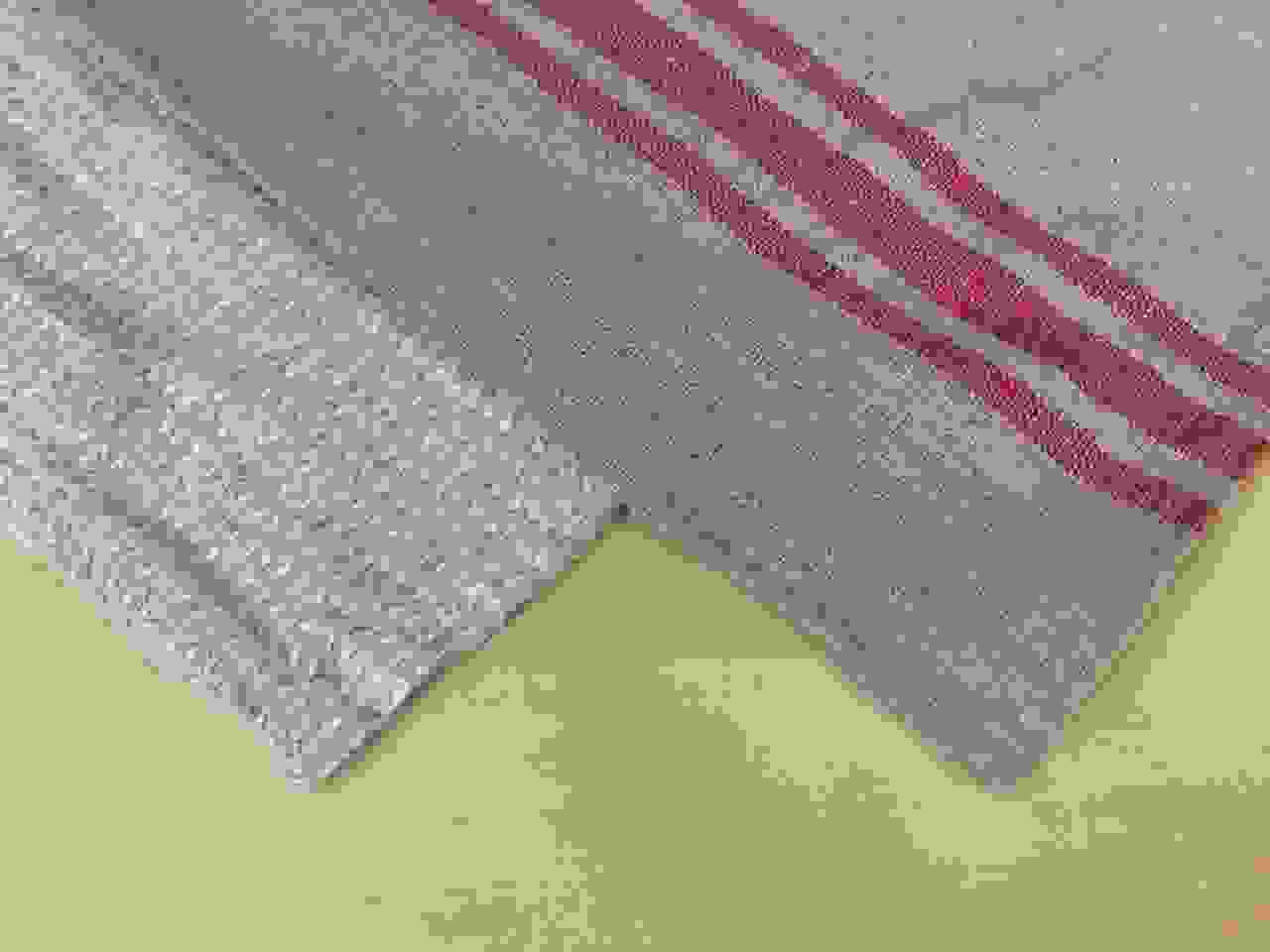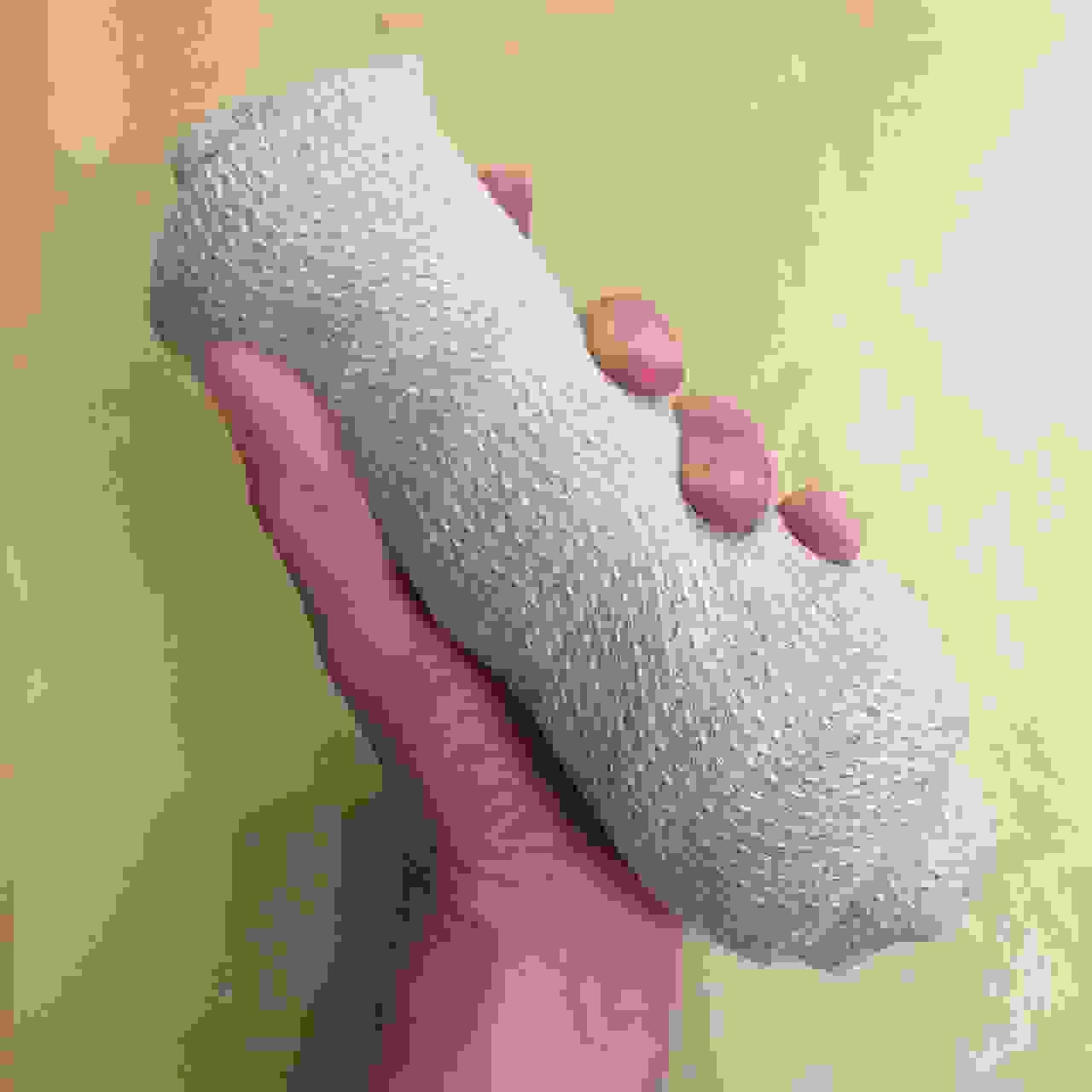Yes, my friends and colleagues, towels. Because despite the seeming irrelevance of such a thing, a compact travel towel is one of the best ways to cut down on bulky items so you can travel with just a minimum of gear. If you’re looking to shrink things down and travel light, travel towels are an absolute must, because:
Regular towels are gigantic, plush monstrosities that rapidly fill up what little space you might have to work with. They’re also made of every traveler’s arch-nemesis fabric: 100% cotton. It’ll work fine, until you have to wash and dry it. Then it’ll stay wet forever, and sooner or later you’ll stuff it into a pack and it’ll smell atrocious once it comes out.
Travel towels, on the other hand, are super-thin and fast-drying, so they’ll take up very little space, and dry out in just a few hours. Even if they’re totally soaked, you can usually leave them out overnight, and they’ll be ready to go by morning. At $20 each, they’re a backpacker’s best friend. You can use them as a bath towel, beach towel, clothes-wringer, or even a blanket.
The problem, however, is that travel towels are usually made of polyester, or some other form of synthetic material. This is great for fast drying times, but terrible for odor resistance. And you know what causes that odor? Bacterial waste products. That’s right, kids! That horrible smell is bacteria poop. And what happens when you’re stuck with a towel that smells a little “off?” You’re smearing it all over yourself. Gross!
So what’s the best travel towel?
Linen.
That’s right. Something a million years old that went out of style when cotton took over the world is going to be the best travel towel you can possibly get. It’s going to be a little pricy (maybe $30 for a bath towel size), but linen has a number of properties that make it ideal for this sort of job.
First of all, it’s highly absorbent. If you’ve ever tried to dry yourself off with polyester, it just…doesn’t…quite…work. That’s because polyester pushes water away. Linen, on the other hand, soaks it right up.
And what really surprised me was that it dries fast. In fact it dries so quickly that it nearly compares to polyester in side-by-side tests, which was the only point of using polyester in the first place.
But it vastly outperforms synthetic fabrics when it comes to odor resistance. Linen is naturally anti-microbial, which means bacteria have a hard time multiplying on its surface. No bacteria = no smell. I used one of these over the course of a month, and never detected even a hint of odor.
Polyester, on the other hand, usually starts smelling weird after just two or three uses…especially if you have to stuff it into a bag before it had a chance to dry out completely. If you’ve ever pulled one of those smelly towels out of a pack after a long day, you’ll know what I’m talking about.
And once you switch to linen, you will never go back.
I have a few of them. Here’s what they look like:

The waffle weave on the left is softer, but bulkier. The one on the right is scratchier (though it softens up over time), but somewhat more compact. Both work just fine, so take your pick.
They’re quite similar in terms of size and weight to a typical travel towel found in camping stores; maybe a little heavier, though it’ll be a matter of just a few extra ounces. They’re about the size of a t-shirt once they’re all rolled up.
Seriously…this is the way to go. You’ll never go back. I will bet you a beer.
Okay, where do I get one?!
The first one I got was from Outlier (one of the few companies combining fashionable and functional clothing, which is the only way clothes should ever be made), who sent me a free one and I’ve been salivating over it ever since. Sadly, they don’t seem to make them anymore…(update: they’ve just restocked them!)
Luckily for you, they’re all over the place. Amazon, eBay, Etsy, and obviously Google. You need to be clever with the search terms though, because “linen” has become a slang term for “sheet” or “towel” or “blanket” or just about any large piece of fabric that belongs in a home. This makes it kind of messy to look up “linen towel” because you’ll find results like “100% cotton bed linens” or other garbage like that. It really annoys me that we’re using the wrong word for something, kind of like how we occasionally use the word “China” for plates, which is ridiculous.
So what you’ll have to do is correctly plug in the exact-match search term, by typing the quotation marks in the proper location, where it’ll–
No. You know what? I’ll just do it for you.
Search for linen towels on:
Those’ll take you to a search specifically for “100% linen” bath towel, with the quotation marks around 100% linen to make it an exact-match search term, so it won’t, for example, show you a towel made of 100% cotton that also happens to have the word linen somewhere on the same page. Hopefully, anyway.
Once you’re there, you can experiment with other search terms, such as bath sheet, which is bigger, and therefore ideal for using as a beach towel or blanket. You can also type the word waffle into the search boxes to get that super-soft waffle weave type shown above. For whatever reason, Etsy seems to be the place to go to find the waffle-weave style, though I also found several on eBay.
You can also just order a couple yards of linen and sew up the edges yourself.
By the way, they make really great kitchen towels. Since they dry faster and resist odor better than cotton, they’re less likely to get sopping wet and smelly over the course of cooking dinner and washing your hands a million times. Obviously there’s a limit to how quickly they can dry out, but it’s noticeably better. They’ll probably last longer, too.
They also work just fine as regular bath towels at home, but I wouldn’t really recommend spending the extra money to replace your old cotton towels, because cotton towels usually have 24 hours to dry before you take your next shower, so drying time isn’t really a big deal…but, on the other hand, the thinner fabric takes up a lot less space in the washing machine, so you can wash more at the same time and save on quarters or electricity costs. There’s certainly nothing wrong with that, but they’re going to be especially useful for travel, camping, or going to the gym, or something like that.
As for alternatives: I’ve heard that sarongs work nicely, since they’re very thin, and usually made of rayon, which is highly absorbent and would dry faster than cotton…but they’re usually made with the intention of being wrapped around a woman’s body, so they’re not necessarily towel-sized or towel-shaped…and although linen isn’t the absolute lightest travel towel you can get (I think the MSR Packtowl Ultralite is the winner in that regard), you could just use a smaller size.
Well, that’s about all I have to say about them. I’m officially convinced: Linen makes the best travel towel you can get. Now that I’ve found them readily available on eBay and Etsy in all sorts of sizes and colors, and at decent prices, I’m officially upgrading this suggestion from “yeah, you’d probably like it” to “just get it, because it’s objectively superior to any conceivable alternative.”
Happy camping/traveling/showering!





is the waffle-weave more absorbent?
I don’t think so, but I think it dries faster, because of the increased surface area. It’s also softer, but the regular weave should soften up over time as well.
Was your waffle weaved towel linty when you first got it? I got one from Etsy and it left lints all over my body when I used it. So I’m wondering if it is the same for all waffle weaved linen.
I didn’t notice anything, but just throw it in the washing machine and see if it improves. Plenty of fabrics start with extra bits like that.
Thanks for the reply!
Linen fabric is notoriously linty. Wash and dry it in a dryer several times and it will be perfect. If you line dry, you will have to shake it well when it gets dry to get the lint to release.
Thank you Laura for the suggestion! I will try to wash and dry it several times and see it that helps.
Thank You! Here in Hawaii, especially on the rainy, tropical side of the Big Island, everything left wet smells and gets moldy overnight. Ugh! After reading your article and researching, I am opting to buy two yards of high quality linen and sew my own towels and washcloths. They will hand wash nicely and will be dry and sweet smelling for the next use. Perfect solution for gifts as well…Mahalo
Yup, they’re definitely better. They’re not completely immune to odor, of course, but they have a higher upper limit.
The french brand seagale sells a Linen towel as well.
https://seagale.fr/en/home/28-linen-travel-towel
By the way do you know where I could by a linen towel in Hanoi, Vietnam ?
Maybe just walk into one of those tailor shops and ask. If they have linen fabric at all, they can just sew up the edges of a big rectangle. Plenty of these places ship abroad, though, if you have time to wait for the shipping.
Thank you for the great tip – we are planning a trip to Japan right now and are eager to test the towels out. What do you think of Ikea’s linen – I think you have one of their kitchen towels judging from the pictures? The kitchen towels actually look pretty good size-wise as travel towels (http://www.ikea.com/us/en/catalog/products/20335224/). Alternatively IKEA also offers linen fabric (http://www.ikea.com/us/en/search/?query=AINA+Fabric&category=products&range_subcategory=10655) in multiple colors.
So that’s the flat weave, rather than the waffle-weave version, so it’ll feel pretty rough to start out with. It’ll soften up over time, but it won’t be as comfy as you’re used to at first. Still, it’ll work. I would probably get a full-size one, though, or cut two yards from the fabric. The kitchen towel size is probably too flat and untextured to be super absorbent.
I Might be too late here but I have the IKEA linen tea towels and they are fine but I’m pretty sure the linen is inferior. After several months in the kitchen they are wearing holes. If you are only using them on bodies for travel it might be ok and likely the cheapest option If you’re good with the size. Im curious if it works for you!
We loved reading your blog post on linen travel towels! We wondered if you have ever tried Turkish towels? We were inspired after travelling through Bali & China, where we travelled through various climates to set up Shore Cotton – an all purpose travel towel, scarf and blanket. Our travel towels are made from 100% Turkish cotton – meaning they are lightweight, versatile, quick drying & stylish.
Check out our website and see what you think :-)
http://www.shorecotton.com
I haven’t tried a Turkish towel, but I’ve tried linen and cotton kitchen towels, and the cotton one took longer to dry and started smelling weird a little faster than the linen, which is why I think the linen would work better in situations where you’d have to travel. Plenty of people use the cotton ones, though, and if they’re thin and the weave is open enough, it can certainly work, but linen is pretty impressive.
i’ll take that Beer bet on linen vs. polyester.
can your linen do what a Chawel towel can do? Far more functionality too
http://www.chawel.com
Those hooded versions and kinda cool, but I’ll still take the odor-resistant performance of linen.
i dont like linen towels. they’re heavy, they dry.. semi-fast and they absorb.. not very well, which is the main issue. Sure, they don’t smell and stuff.
A microfiber towel dries (much) quicker, absorbs much better and is lighter. Only draw back: it smells quickly if you dont wash it. But usually, if you use such a towel.. you got a water source to wash it.
Hmm…ah well. Everyone’s different. I tend to prefer the way linen absorbs. Some of the fluffier travel towels can work pretty well, but I kept running into trouble with the smell.
Is there differences in those 100% pure Linen? The price range gap seems pretty huge. Some is cheap some is like double or triple the price.
I think there are various qualities of linen, but I don’t think it matters when it comes to towels. I think the difference is the “slub.” Slub fibers basically look like really thick yarns, compared to all the thinner yarns around it. It’s really obvious in linen that some yarns are quadruple the size of the one right next to it, which looks weird when you’re trying to look dressy, but I don’t think it matters when it comes to towels, which no one will care about. That’s what I’m guessing, anyway.
Thanks, Eytan this is a really helpful post on towel fabrics. I’ve been researching linen as potential fabric for our next line of travel beach towels. I think, in addition to the advantages you’ve listed here, they might be more environmentally friendly than polyester as well because linen is ultimately bio-degradable.
Always happy to hear that my complaining is changing the world.